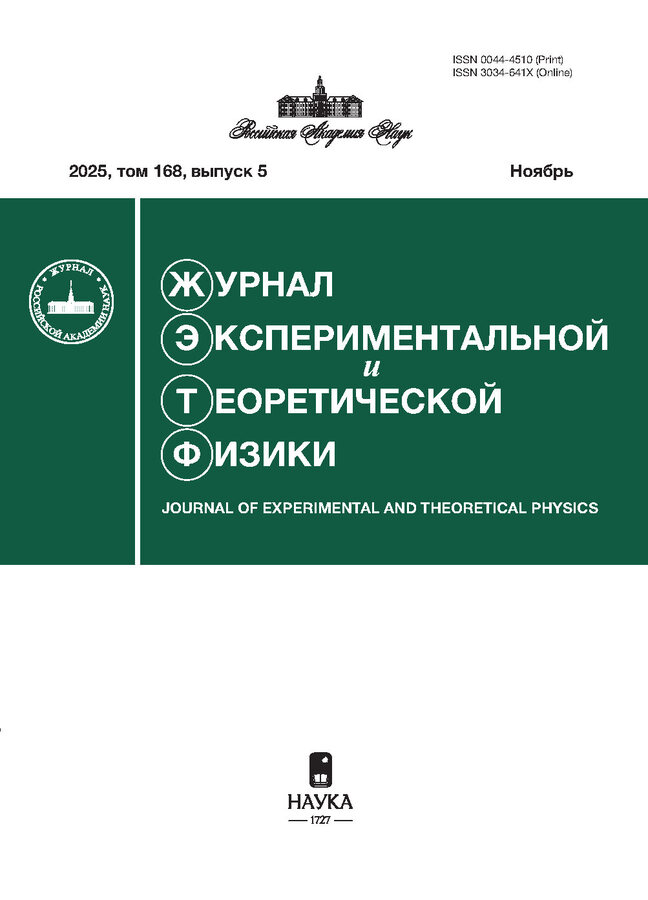Influence of the Effects of Competition of Various Types of Anisotropy on the Critical Behavior of Magnetic Multilayer Structures
- Authors: Min'kova A.V.1, Prudnikov V.V.1, Prudnikov P.V.1,2
-
Affiliations:
- Dostoevsky Omsk State University
- Center of New Chemical Technologies, Boreskov Institute of Catalysis, Siberian Branch, Russian Academy of Sciences
- Issue: Vol 164, No 5 (2023)
- Pages: 782-789
- Section: Articles
- URL: https://journals.rcsi.science/0044-4510/article/view/247338
- DOI: https://doi.org/10.31857/S0044451023110081
- EDN: https://elibrary.ru/PJKBKX
- ID: 247338
Cite item
Full Text
Abstract
The influence of the competition of single-ion anisotropy and easy-plane anisotropy on the magnetic properties of the multilayer structure Co/Cu/Co is investigated. The peculiarities of the influence of anisotropy effects are revealed both in the vicinity of critical temperature Tc and in the low-temperature range T < Tc. The magnetic properties of the multilayer structure are numerically simulated using the anisotropic Heisenberg model. In the vicinity of Tc, easy-plane anisotropy is shown to exert a predominant influence on the magnetic properties of the structure as compared to the influence of single-ion anisotropy. In the low-temperature range, the switching of the magnetic state of the ferromagnetic film in an external field leads to the appearance of specific features in hysteresis effects due to the competition of two types of magnetic anisotropy. The magnetic structure exhibits a size-induced transition from the behavior caused by easy-plane anisotropy to the behavior caused by single-ion anisotropy. The revealed size-induced transition is accompanied by a spin-flop effect.
About the authors
A. V. Min'kova
Dostoevsky Omsk State University
Email: minkovaav@omsu.ru
644077, Omsk, Russia
V. V. Prudnikov
Dostoevsky Omsk State University
Email: minkovaav@omsu.ru
644077, Omsk, Russia
P. V. Prudnikov
Dostoevsky Omsk State University; Center of New Chemical Technologies, Boreskov Institute of Catalysis, Siberian Branch, Russian Academy of Sciences
Author for correspondence.
Email: minkovaav@omsu.ru
644077, Omsk, Russia; 644040, Omsk, Russia
References
- G. Mihajlovi'c, N. Smith, T. Santos, J. Li, B. D. Terris, and J. A. Katine, Appl. Phys. Lett. 117, 242404 (2020).
- R. B. Morgunov, G. L. L'vova, A. D. Talantsev, O. V. Koplak, T. Fache, and S. Mangin, J. Magn. Magn. Mater. 459, 33 (2018).
- C. C. Huang, X. Zhou, and D. A. Hall, Sci. Rep. 7, 45493 (2017).
- J. Sarkar, Sputtering Materials for VLSI and Thin Film Devices., Elsevier, Amsterdam (2014).
- M. T. Johnson, P. J. H. Bloemen, F. J. A. den Broeder, and J. J. de Vries, Rep. Prog. Phys. 59, 1409 (1996).
- C. A. F. Vaz, J. A. C. Bland, and G. Lauho, Rep. Prog. Phys. 71, 056501 (2008).
- P. V. Prudnikov, V. V. Prudnikov, and M. A. Medvedeva, JETP Lett. 100, 446 (2014).
- A. O. Adeyeye, G. Shimon, Magnetism of Surfaces, Interfaces, and Nanoscale Materials. Handbook of Surface Science., Elsevier, Amsterdam (2015).
- B. Heinrich, T. Monchesky, and R. Urban, J. Magn. Magn. Mater. 236, 339 (2001).
- P. V. Prudnikov, V. V. Prudnikov, M. A. Menshikova, N. I. Piskunova, J. Magn. Magn. Mater. 387, 77 (2015).
- P. V. Prudnikov, V. V. Prudnikov, A. Yu. Danilova, V. O. Borzilov, and G. G. Baksheev, EPJ Web Conf. 185, 11009 (2018).
- F. Huang, M. T. Kief, G. J. Mankey, and R. F. Willis, Phys. Rev. B. 49, 3962 (1994).
- R. A. Duine, K. J. Lee, S. Parkin, and M. D. Stiles, Nat. Phys. 14, 217 (2018).
- V. V. Prudnikov, P. V. Prudnikov, M. V. Mamonova, M. M. Firstova, and A. A. Samoshilova, J. Phys.Commun. 3, 015002 (2019).
- M. Pajda, J. Kudrnovsky, I. Turek, V. Drchal, and P. Bruno, Phys. Rev. B. 64, 174402 (2001).
- T. Tanuma, S. Takahasi, M. Kume, and K. Kuroki, J. Magn. Soc. Jpn. 18, S1 (1994).
- Y. Chen, M. Kadic, and M. Wegener, Nat.Commun. 12, 3278 (2021).
- A. Fern'andez-Pacheco, R. Streubel, O. Fruchart, R. Hertel, P. Fischer, and R. P. Cowburn, Nat.Commun. 8, 15756 (2017).
Supplementary files










